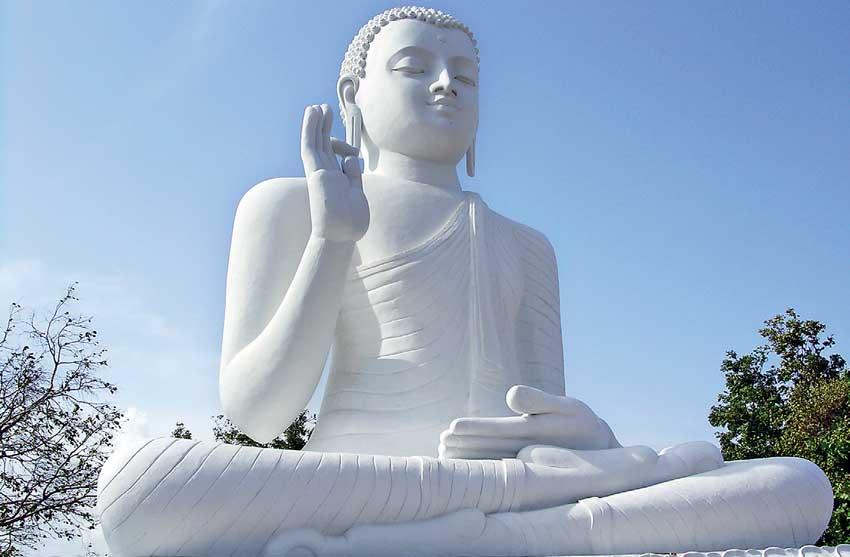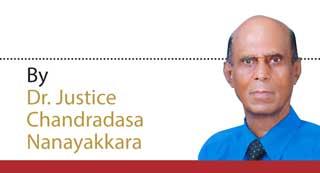14 May 2022 - {{hitsCtrl.values.hits}}

Statue of The Buddha at Mihintale
Buddhists believe that there are three characteristics that are common across everything in life. They are known as the Three Marks of Existence or Three Universal Truths
The Buddha applies the characteristic of suffering to all conditioned things in the sense that for living beings, everything conditioned is a potential cause of experienced suffering and is at any rate incapable of giving lasting satisfaction
Buddhism rests on the pivot of suffering. Buddha perceived the universality of suffering and propounded a remedy (Noble Eightfold Path) for the universal sickness of humanity. By that Buddhism does not denote an attitude of hopelessness toward life
 Buddhism is a moral and philosophical system, which expounds a unique path of enlightenment, and it is mainly aimed at liberating human beings from suffering.
Buddhism is a moral and philosophical system, which expounds a unique path of enlightenment, and it is mainly aimed at liberating human beings from suffering.
Buddhists believe that there are three characteristics that are common across everything in life. They are known as the Three Marks of Existence or Three Universal Truths.
The three characteristics are (1) impermanence (Annica) (sabbe saṅkhārā aniccā), (2) suffering or unsatisfactoriness (dukka) (sabbe saṅkhārā dukkhā) and (3) non-self or insubstantiality (annatta)(sabbe dhammā anattā). These three basic facts were first found and formulated over 2500 years by omniscient Buddha (loka vido) who lived more than 2500 years ago. In Buddhist terminology, these characteristics were collectively designated as (ti lakkana).
The three characteristics are incontrovertible facts applying to animate and inanimate things. Whether Buddha’s arise or not these truths exist in the world.
The Buddha teaches that life can be correctly understood only if these basic facts are understood. And this understanding must take place, not only logically, but in the light of one’s own experience. It is through understanding these characteristics that wisdom arises, only then can one free oneself from the bonds of rebirth and attain bliss of Nibbaṇa, which is the ultimate liberating factor in Buddhism.
In Buddhism, to see things as they really are means to see them consistently in the light of the three characteristics. Not to see them in this way, or to deceive oneself about their reality and range of application, is the defining mark of ignorance (avijja). Being ignorant of our true nature, and of the true nature of things around us, we tend to engage in actions based on delusions and thereby we accumulate karma which keeps us in bondage to the repeated cycle of rebirth and death. Dissolving that ignorance through direct insight into the three marks is said to bring an end to saṃsāra and resulting suffering (dukkha nirodha or nirodha sacca, as described in the third of the Four Noble Truths).
Therefore, ignoring or distorting the three basic facts ultimately leads only to frustration, disappointment and despair. The proper discernment of the three characteristics is bound to yield immense benefits both in our daily lives and in our mental striving for higher states.
Clear comprehension of three characteristics will give us insight into real-life situations that are complex and painful. It will free us from unrealistic expectations, bestow a courageous acceptance of suffering and failure, and protect us against the lure of deluded assumptions and beliefs.
Referring to these three universal Truths, Rev. Nyanaponika says if we contemplate even a minute sector of life’s vast range, we are faced with a variety of living forms so tremendous that it defies description. Yet three basic features can be discerned as common to everything that has animate existence, from microbe to man, from the simplest sensations to the thoughts of a creative genius: (i) first, impermanence or change (anicca), (ii) second, suffering or unsatisfactoriness (dukkha) and (iii) third, non-self or insubstantiality (anatta). . . .
The first characteristic, impermanence is one of the fundamental teachings of Buddhism, which can be observed in the entire nature of the universe. We can visualise four areas of impermanence; physical, emotional, mental, and social. We can see how the physical world is changing by the periodic changes of the seasons, ageing, sickness and death. In the emotional world we can see impermanence through the constant changes of feelings and emotions as one moment we might be euphoric, happy and elated next moment feeling sad and melancholy.
Mentally our ideas, thoughts and concepts change from time to time and new ideas and concepts come into being. Lastly, from the social perspective, we form new relationships, we meet new people, we separate from our dear loved ones, we change our employments and get into new jobs, eventually, we lose our loved and dear ones etc.
Contemplating on impermanence brings to the surface the dreadful truth that everything we have acquired, earned and accomplished, all our precious possessions, material things even our most intimate and cherished relationships, our loved ones inevitably succumb to time and deteriorate and cease to exist.
The renowned Greek Philosopher Heraclitus once declared, “No man ever steps in the same river twice, for it is not the same river, and he is not the same man”. There is no static being no unchanging substratum. In his notes to the novel “Chance” one of the greatest Polish British novelists Joseph Conrad stated thus “The history of men on this earth may be summarised in one phrase of infinite poignancy “They were born, they suffered, they died”. Similarly, James brother of Jesus according to the New Testament ask “Why you do not even know what will happen tomorrow. What is your life? You are but a mist that appears for a little while and then vanishes” (James 4:14).
All component things that is all things which arise as an effect of causes, and which in turn give rise to effects, are embodied in the single word annicca.
Impermanence is also closely linked to the truth of suffering, which constitutes the first noble truth in Buddhism. The Lord Buddha taught us that the cause of human suffering and discontent is brought about by our clinging to worldly things under the mistaken belief that they will last and endure forever, which is in fact not so.
Man has achieved great marvellous things throughout the centuries, his ingenuity and strength have enabled him to conquer space and subdue matter to his will. Yet for all his capabilities and ingenuity, he still remains fragile and vulnerable in the face of impermanence.
Impermanence highlights the mortality and inevitable decline of mighty leaders and their false pride, how time has brought to an end the commanding powers of great leaders in the world. When we look at the ruins of great Stupas and edifices in places like Anuradhapura and Polonnaruwa, we can see how they have been subjected to the natural process of decay with the passage of time.
The second characteristic dukka is an important concept in Buddhism, commonly referred to as suffering unhappiness, pain or unsatisfactoriness. It refers to the habitual experience of mundane life as fundamentally unsatisfactory and painful. It is also the first of the Four Noble Truths. The Buddha applies the characteristic of suffering to all conditioned things in the sense that for living beings, everything conditioned is a potential cause of experienced suffering and is at any rate incapable of giving lasting satisfaction.
Buddhism rests on the pivot of suffering. Buddha perceived the universality of suffering and propounded a remedy (Noble Eightfold Path) for the universal sickness of humanity. By that Buddhism does not denote an attitude of hopelessness toward life. Buddha did not expect his adherents to be constantly brooding over the ills of life and so make their lives unhappy.
If you look at the world with dispassionate discernment it becomes abundantly clear that there is only one problem in the world, which is suffering, dukka. Buddha says “The world is established on suffering, is founded on suffering” (Dukkhe loko patitthito). Suffering appears and passes away, only to reappear in other forms. All forms of suffering are either physical or psychological. All is in a whirl, nothing escapes this inexorable, unceasing change.
According to Buddha, Birth is suffering, decay is suffering, illness is suffering, sorrow, lamentation, pain, grief and despair are suffering; to be connected with what one dislikes is suffering; to be separated from what one likes is suffering; not getting what one desires is suffering in short, the five aggregates connected with clinging are suffering.
Anatta (Sanskrit anatman) refers to the doctrine of “non-self”, that there is no unchanging, permanent self or soul in living beings and no abiding essence in anything or phenomena.
While anicca and dukkha apply to “all conditioned phenomena” (saṅkhārā), anattā( third characteristic) has a wider scope because it applies to all dhammās without “conditioned, unconditioned” qualification. Thus, nirvana too is a state of “without self” or anatta. The phrase “sabbe dhamma anatta” includes within its scope each skandha (aggregate, heap) that composes any being, and the belief “I am” is a mark of conceit which must be destroyed to end all dukkha. The Anattā doctrine of Buddhism denies that there is anything called a ‘Self’ in any person or anything else and that a belief in ‘Self’ is a source of Dukkha.Some Buddhist traditions and scholars, however, interpret the anatta doctrine to be strictly in regard to the five aggregates rather than a universal truth.
Gautama Buddha taught us that all beings conditioned by causes (saṅkhāra) are impermanent (anicca) and suffering (dukkha), and that not-self (anattā) characterises all dhammas, meaning there is no “I”, “me”, or “mine” in either the conditioned or the unconditioned
26 Dec 2024 9 hours ago
26 Dec 2024 26 Dec 2024
26 Dec 2024 26 Dec 2024
26 Dec 2024 26 Dec 2024
26 Dec 2024 26 Dec 2024